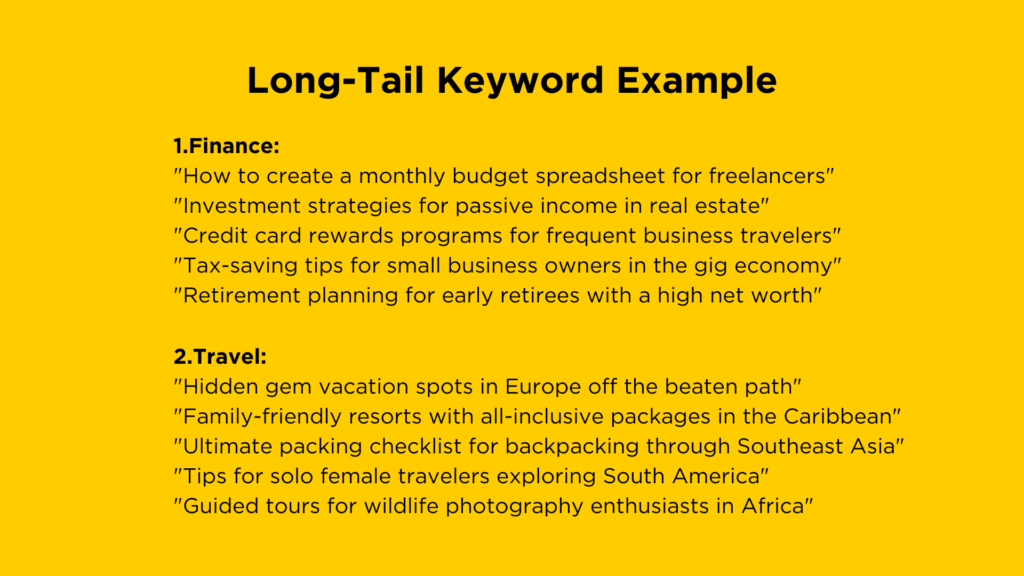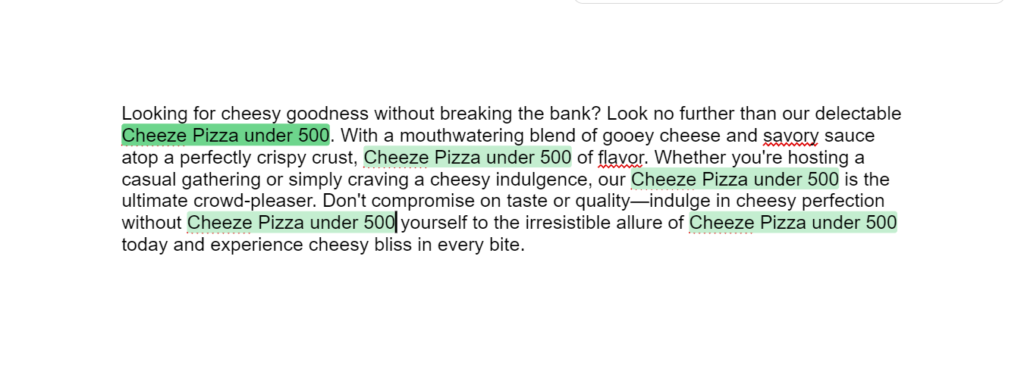Understanding long-tail keywords is essential for boosting your website’s visibility on search engines like Google.
Here’s what you should know:
Definition: Long-tail keywords are longer and more specific phrases people use online searching.
They may not get as many searches as short, general keywords, but they often lead to higher conversion rates.
Importance: Long-tail keywords are crucial for SEO because they help you reach a specific audience interested in your products or services.
They can increase your chances of appearing in search results for niche topics, leading to more qualified traffic and better results.
Purpose: This guide aims to provide a detailed understanding of long-tail keywords, including why they’re valuable, how to find them, and the best ways to use them to improve your website’s performance in search engine rankings.

FAQ
Q: What are long-tail keywords?
A: Long-tail keywords are longer, more specific phrases used when searching online, helping to target niche audiences effectively.
Q: Why are long-tail keywords important for SEO?
A: Long-tail keywords are vital for SEO because they attract highly targeted traffic, boost conversion rates, and help businesses compete effectively in specialized markets.
Understanding Long-Tail Keywords
Long-tail keywords are like the secret sauce of SEO, helping you reach the right people at the right time.
Here’s what you should know:
Definition: Long-tail keywords are longer and more specific phrases that people type into search engines, usually three words or more.
Unlike short, general keywords, long-tail keywords get to what users seek.
Characteristics: Long-tail keywords are unique because they Have Lower Search Volume.
They might not get searched as often as short keywords, but when they do, they tend to bring in visitors who are more likely to take action.
Offer Higher Conversion Rates: Since they’re so specific, people using long-tail keywords often know precisely what they want, making them more likely to purchase or engage with your content.
Benefits: Long-tail keywords are your ticket to:
Targeted Traffic: They attract people actively looking for what you offer, increasing the chances of turning them into customers.
Lower Competition: Because they’re so specific, there’s less competition for long-tail keywords, making it easier for your website to rank higher in search results.
Enhanced Relevance: Long-tail keywords let you create content that’s precisely tailored to what your audience is searching for, making it more valuable and engaging.
Examples: Long-tail keywords look like this: “best running shoes for flat feet,” “affordable vegan restaurants in Chicago,” or “how to train a Labrador puppy.”
FAQ
Q: Why are they called “long-tail”?
A: Long-tail keywords get their name from the shape of a distribution curve, with the “long tail” representing the less frequently searched but concrete terms.
Q: Can any business benefit from long-tail keywords?
A: Absolutely! Long-tail keywords work for businesses of all shapes and sizes.
They benefit smaller companies and niche markets, where targeting specific audiences can lead to better results.
Advantages of Long-Tail Keywords
Long-tail keywords are helpful for SEO because they help you connect with potential customers more intensely.
Check out these perks:
- Narrowing Down Your Audience: Long-tail keywords let you target specific groups interested in niche topics or products, increasing the chances of turning visitors into buyers.
- Less Competition: Since long-tail keywords are so specific, there’s less competition from other websites. This means your content has a better chance of ranking higher in search results.
- Boosted Conversion Rates: People using long-tail keywords usually know precisely what they want. This means they’re more likely to take action, like purchasing or signing up for a service.
- Tailored Content: Long-tail keywords help you create content that speaks directly to what your audience is looking for, leading to more engagement and happier visitors.
- Building Traffic Over Time: Even though individual long-tail keywords might not get tons of searches, together, they can bring in a lot of traffic over time, which helps your website grow steadily.
FAQ
Q: Are long-tail keywords better than short ones?
A: Long-tail keywords serve a different purpose than short ones. While short keywords might bring in more traffic, long-tail ones often lead to higher conversion rates because they’re more specific and relevant.
Q: How can I find the right long-tail keywords for my business?
A: You can discover long-tail keywords using tools like Google Keyword Planner, SEMrush, or Ahrefs.
Look for phrases related to your business with moderate search volume and low competition.
Finding Long-Tail Keywords Made Simple
Discovering long-tail keywords is all about using innovative strategies to find specific phrases that match what your audience is searching for.
Here’s a straightforward guide to help you find long-tail keywords effectively:
1. Think About Relevant Topics: Start by brainstorming topics related to your business or what you offer.
Consider the problems your products or services solve.
2. Use Keyword Tools: Tools like Google Keyword Planner, SEMrush, or Ahrefs can help.
They provide data on search volume, competition, and other related keywords based on your topics.
3. Check Auto-Suggestions and Related Searches: Notice what pops up when typing in Google’s search bar.
These auto-suggestions often contain long-tail keyword ideas based on what others are searching for.
4. Spy on Your Competitors: Look at what keywords your competitors are using.
Tools like SEMrush and Ahrefs let you peek at the keywords driving traffic to their sites.
5. Listen to Your Customers: Pay attention to what your customers are saying.
Their feedback, reviews, and questions can reveal specific phrases they use, which you can turn into long-tail keywords.
FAQ
Q: How many words should a long-tail keyword have?
A: Long-tail keywords usually have three or more words, but there’s no strict rule.
Focus on capturing the specific intent behind the search rather than worrying about the word count.
Q: Can I use long-tail keywords for paid advertising?
A: Absolutely! Long-tail keywords work well for paid ads, especially for targeting niche audiences and reducing competition.
They often lead to better conversion rates and lower costs than broader keywords.
Incorporating Long-Tail Keywords into Your Content Strategy
Adding long-tail keywords to your content plan is crucial for boosting your website’s visibility and attracting exemplary visitors.
Here’s how you can do it effectively:
Understand What Users Want: Figure out what your audience is searching for and what problems they’re trying to solve before adding long-tail keywords.
Create Great Content: Develop helpful and exciting content that naturally includes long-tail keywords.
Make sure your content provides real value and answers your audience’s questions.
Use Keywords Naturally: When using long-tail keywords, ensure they fit naturally into your content.
They should flow smoothly within your text without feeling forced.
Optimize Meta Data: Put long-tail keywords in your meta titles, descriptions, and headers.
This helps search engines notice your content and encourages people to click.
Try Different Types of Content: Use various content formats like blogs, articles, videos, infographics, and podcasts to target different long-tail keyword variations and appeal to other types of audiences.
FAQ
Q: How many long-tail keywords should I use in one piece of content?
A: There’s no set number. Use keywords that fit naturally and relate to your content’s main topic and purpose.
Q: Can I use long-tail keywords in any type of content?
A: Yes, you can use long-tail keywords in blogs, product descriptions, landing pages, videos, and more.
Just make sure they make sense and add value to your content.
Optimizing Content for Long-Tail Keywords: Key Strategies
Making your content stand out for long-tail keywords means using intelligent methods to ensure your website shows up well in search results and attracts the right people.
Here are some top tips for doing just that:
Keyword Placement: Put long-tail keywords naturally into your content, like titles, headers, meta descriptions, and paragraphs.
This helps search engines know your content fits what people are searching for.
Create Detailed Content: Write thorough content that covers the topic related to your long-tail keyword.
Give lots of information, answer common questions, and solve problems your audience might have.
Use Different Words: Include words similar to your main long-tail keyword to capture different searches while staying on topic.
This helps more people find your content and makes it more inclusive.
Make Images Search-Friendly: Optimize your website images by giving them names and alt text that include relevant long-tail keywords.
This helps search engines understand what your images are about.
Keep an Eye on Results: Use analytics tools to check how well your optimized content is doing regularly.
Look at how much traffic you’re getting and how many people click on your links.
This helps you know what’s working and what needs tweaking.
FAQ
Q: How long does it take to see results from optimizing for long-tail keywords?
A: It varies based on things like how popular your website is, how many competitors you have, and how good your content is.
Generally, seeing significant changes in search engine rankings and traffic can take a few weeks to several months.
Q: Can I make my existing content better for long-tail keywords?
A: Absolutely! Find relevant long-tail keywords and naturally add them to your existing content.
Update titles, headers, and text to match the new keywords, making your content more visible in searches.
Common Mistakes to Avoid
Some common errors can hinder your SEO progress when it comes to using long-tail keywords.
Here’s a simple breakdown of what to avoid:
1. Keyword Stuffing: Putting too many long-tail keywords into your content can make it seem forced and unfriendly to users.

2. Ignoring User Intent: Not understanding what users want when they search with specific long-tail keywords can lead to content that misses the mark.
3. Neglecting Content Quality: Prioritizing keywords over good content can result in shallow, unhelpful material that doesn’t engage your audience.
4. Not Monitoring Performance: Forgetting to monitor how your optimized content is doing can mean missing opportunities to improve it.
5. Ignoring Analytics Data: Ignoring data from analytics tools, like how long people stay on your page or where they click, means missing valuable insights to improve your content.
FAQ
Q: How do I avoid keyword stuffing?
A: Make your content valuable and informative, naturally weaving in long-tail keywords. Strike a balance so it reads well and avoids keyword stuffing.
Q: Why is understanding user intent necessary?
A: Understanding what users are searching for ensures your content matches their needs, which boosts the chances of attracting the right audience and keeping them engaged.
Conclusion
As we wrap up our discussion on long-tail keywords, let’s summarize the key points we’ve covered:
Why Long-Tail Keywords Matter: Long-tail keywords are crucial for SEO because they help you target specific audiences and increase conversion rates.
Using Long-Tail Keywords Wisely: Knowing how to find, use, and optimize long-tail keywords can significantly boost your SEO strategy.
Keep Improving: SEO is a continuous process, so it’s essential to regularly check, analyze, and refine your long-tail keyword strategy to stay competitive.
Understanding Your Audience: Throughout our talk, we’ve stressed the importance of knowing what your audience wants. This remains central to SEO success.
FAQ
Q: Do I need to use long-tail keywords in every piece of content?
A: While they can be helpful, long-tail keywords aren’t always necessary for every piece of content.
It’s more important to consider whether they align with your content’s focus and audience’s interests.
Q: What’s the main lesson from our discussion on long-tail keywords?
A: The key takeaway is that focusing on your audience’s wants and crafting content to meet their needs is vital for SEO success.
Doing this can improve your website’s visibility and attract more relevant traffic.